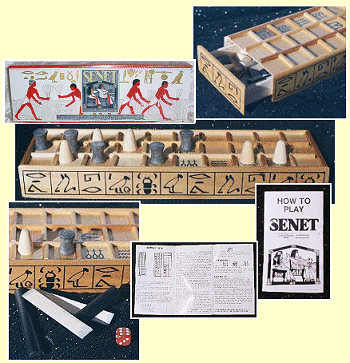
PLEASE NOTE: This is an archive of our original site, for informational purposes only. We no-longer have a sales catalogue.

The Game of Thirty Squares: The Ancient Egyptian Game of SenetAs many as fifty senet boards have been found amidst the finery and flotsam in ancient Egyptian tombs, from the glory of the table-sized board found in King Tut's tomb to simple boards found in the graves of more ordinary folk -- this was clearly a game known by all during its time. It was, in fact, so well known that apparently no one bothered to write down the rules. Current sets of rules are either based on knowledge of the many depictions of the game being played, as well as a few references to it and on study of the people who played it (as in the version of the rules by Timothy Kendall) or on play-testing the game with a little knowledge of its origins and the meaning of its markings and pieces.
|
|
| While boards have been found in the tombs of the pharoahs, they have also been found formed into the tops of high walls, perhaps by masons taking a break from the chores of building the great structures of the time. The three-rows-of-ten squares design has been found repeated in great buildings, and even in antechambers to tombs, taking the game up to life-sized. |
 |
|
It is thought by some that the board was originally designed as a calendar, tracking the 30 days of the Egyptian month -- and only later did it develop into a game. It apparently evolved farther, still, as over time it became so much a part of the warp and woof of Egyptian life that it entered into the realm of religious practice: it seems to have been thought that a game played with unknown forces shortly after death would determine whether the dead would get to enter a peaceful eternity or not, as depicted in many murals within tombs showing the deceased playing the game against an unseen opponent. Because the game developed a religious significance, when Christianity began to spread throughout the region in which Senet was played, the game was put down as pagan, lost favor, and for a long while disappeared in its original form, until rediscovered by archeologists during the last century. The game, as found in many tombs, was played with throwing sticks -- a binary form of dice first made by taking a cut of a branch of a tree and cutting it in half down its length -- to make two dice, each with one round and one flat side. Throw four such dice and you have five possible outcomes -- one flat, two flat, three flat, four flat or none flat -- with throws of four or none flat being fairly rare. "None" was probably counted as "five". (The balance of the game would be substantially changed by using a six-sided die like those in modern games -- using throwing sticks when playing Senet is highly recommended.) Each player has distinctively shaped playing pieces -- either five or seven, depending on the rules you're using (both five and seven were found in ancient Senet games). These were shaped like cones or reels, and painted different colors. They were called "ab" which meant dancers -- as they danced along the board representing life. Senet boards were marked in various ways, but the 15th square, as well as the 26th through 30th squares were consistently marked in ways that lead us to understand their significance. The 15th square was usually marked with an Copyright © 2003 Astral Castle, All Rights Reserved Worldwide.
|
|
Sources and Links: